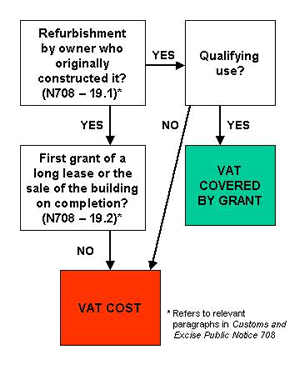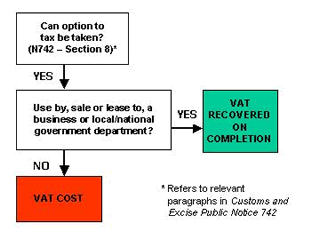VALUE ADDED TAX
Implications for Historic Buildings
Roger Wood
Value Added Tax (VAT) is a significant additional cost that has to be borne by those responsible for the preservation and conservation of our architectural heritage. VAT is charged on building work of all descriptions at the standard rate (17.5 per cent at the time of writing) unless it can be 'zero-rated' or charged at the reduced rate of five per cent. This reduced VAT rate, introduced with effect from 12 May 2001, applies only to building work carried out in the following circumstances:
- renovation of a single dwelling which has been empty for three years or more
- conversion of a dwelling resulting in a change in the number of dwellings (eg from two houses into one)
- conversion of a dwelling into a multiple occupation dwelling (ie converting a house into flats)
- conversion of a non-residential property into a single household dwelling or number of dwellings
- conversion of a dwelling or multiple occupation dwelling into a building intended for 'relevant residential purposes' (see table of definitions below).
This new legislation is very complex and as yet untested by the courts. It is therefore essential that the rules are considered in full when determining whether a new five per cent rate can be applied.
Under the current legislation the five per cent reduced rate can only be applied to buildings used for either a relevant residential or charitable purpose. The government recognised the apparent imbalance and have attempted to redress it by introducing the Listed Places of Worship Grant Scheme. This new scheme, which was formally launched on 4 December 2001, aims to replace the difference between the 17.5 per cent standard rate and five per cent reduced rate in grant aid. This effectively puts eligible works undertaken on listed places of worship on a level footing with other listed charitable buildings.
Zero-rating is not granted automatically, and the burden is placed on the owner of the building to 'evidence' or prove that the works undertaken are not liable to VAT at the standard rate. Unfortunately there is no general relief for historic and listed buildings. The relief is dependent on the individual circumstances of the particular project, as illustrated in the flow charts below.
Perhaps the most important point to bear in mind before embarking on any project is to ensure that the appropriate planning and listed building consent is granted before any work on the building is undertaken. Although this may seem obvious, HM Customs and Excise will not grant any zero-rating relief if the planning and listed building consents are retrospectively granted.
It should be noted that, in the world of VAT, ordinary phrases such as 'approved alterations', 'qualifying use', 'relevant charitable purpose', 'relevant residential purpose' and 'substantial reconstruction' have taken on alternative meanings that are specific to VAT. You should not assume that they have the usual meanings and in cases of doubt seek further advice.
LISTED PLACES OF WORSHIP GRANT SCHEME
This
scheme returns in grant aid the difference between five per cent and the
actual amount (normally 17.5 per cent) of VAT paid on eligible repairs
and maintenance to listed places of worship.
 |
The grant scheme applies to listed places of worship of all religions throughout the UK, and covers work carried out on or after 1 April 2001. To qualify, places of worship must be owned by or be vested in a number of specified organisations which look after churches, and the relief applies only to repairs and maintenance to listed buildings that are used principally as places of worship. The grant scheme is intended to bridge the two-year gap leading up to a 2003 review of the Government's proposals to the European Commission for a reduced VAT rate of 5 per cent on such repairs to listed places of worship. Further information on the scheme and eligibility can be found at www.lpwschme.org.uk. |
LISTED BUILDING ALETRATIONS AND RECONSTRUCTION WORK
 |
Work to a 'protected building' (which includes listed buildings and scheduled monuments) can only be zero-rated if it is an 'approved alteration' or a 'substantial reconstruction'. In addition, the refurbished building must be used as either a dwelling, for 'relevant residential purpose' or for a 'relevant charitable purpose'. Professional fees can never be zero-rated. For example, no VAT should be charged on materials and services used in the alteration of a qualifying listed building. You should remember that only costs related to the alteration work will be eligible for the zero rate. However, if the building is largely demolished, a developer should be able to recover all the VAT incurred on the redevelopment (including repairs) when he sells it.
|
CONVERSIONS
A more general relief from VAT is provided to any non-residential building which is converted into a dwelling or for use solely for a relevant residential purpose. To qualify for the relief, however, the building must be sold or leased for more than 21 years once the conversion has been completed. For example, a disused warehouse (listed or not) could be converted to flats and their sale (or long lease of more than 21 years) could be zero-rated, thus allowing the VAT incurred on the conversion, alteration and professional fees to be recovered. There are similar rules for housing associations which allow them to request that contractors zero-rate work done for them in converting non-residential buildings to dwellings or residential homes. |
 |
BUILDINGS IN ORIGINAL OWNERSHIP
 |
Many old buildings are still in the ownership of the organisation that originally constructed them (such as churches, universities and hospitals). Provided that the building can be sold or subject to a long lease and is being used, or to be used, for a 'qualifying use', then work may be zero-rated, allowing recovery of the tax incurred on completion of the refurbishment. |
'OPTION TO TAX' - PROPERTY DEVELOPMENT FOR BUSINESS USE
If the restored building is going to be sold or put to business use, then the 'option to tax' can be taken. Under such an option, VAT is charged on the sale price or lease rents, and this allows any VAT incurred on the restoration to be reclaimed. HM Customs and Excise has legislated that in certain circumstances it can direct that the option to tax be disapplied for any particular transaction. The effect of such a ruling would be that VAT would not have to be charged on the sale or lease of the property, but any VAT paid on the restoration would not be recoverable. |
 |
SOME USEFUL DEFINITIONS
Approved alterations: alterations which cannot be carried out without
Listed Building Consent and have received such consent — these do
not include repairs or 'incidental alterations' which are carried out
as a result of the need to repair the structure of the building
Protected
building: alisted building or scheduled monument
Dwelling: house, flat or similar
Long lease: a lease in excess of 21 years
Option to tax: the option can be exercised by anybody to enable
VAT to be charged on most property transactions which would otherwise
be exempt, excluding transactions involving dwellings and certain other
types of property
Qualifying use: use of the building for a relevant charitable purpose
(see below) or a relevant residential purpose (see below)
Relevant charitable purpose: use by a charity for non-business
activities or to provide social or recreational activities for a local
community
Relevant residential purpose: a home providing residential accommodation,
student accomodation or personal care, including army accomodation, hospices
or any institution which is the sole or main residence of 90 per cent
of its residents
Substantial reconstruction: no more than the external walls of
the building remain, and/or the total cost of the approved alterations
(excluding repairs) represents 60 per cent or more of the total cost of
the work.



